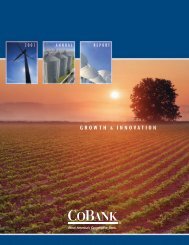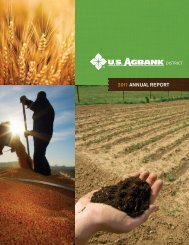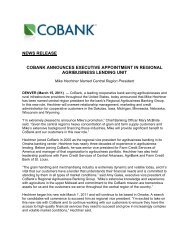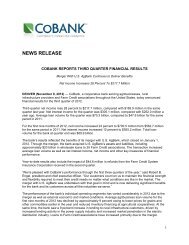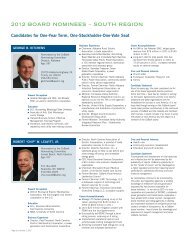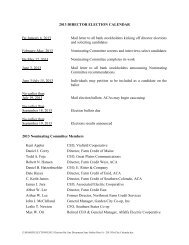As a condition of the merger with AgBank, effectiveJanuary 1, 2012, the FCA requires <strong>CoBank</strong> to maintain aminimum days liquidity of 130 (40 days greater than the90 day regulatory minimum). Additionally, throughDecember 31, 2014, if days liquidity were to fall below 150for five consecutive days, the Bank must notify the FCA andsubmit to them a written plan to restore and maintain the 150days level.Our liquidity plan covers certain contingencies in theevent our access to normal funding mechanisms is disrupted.We purchase only high credit quality investments to ensureour investment portfolio is readily marketable and available toserve as a source of contingent funding. Our investmentportfolio may also be used as collateral to borrow funds tocover maturing liabilities. Pursuant to FCA regulations, nonagencymortgage- and asset-backed securities that are nolonger rated triple-A by at least one major rating agency mustbe excluded from our liquidity reserve. In addition, suchsecurities must be disposed of within six months of beingdowngraded unless approval to continue to hold thesesecurities is obtained from the FCA. Approximately$192.7 million of our non-agency investment securities havebeen downgraded to ratings below triple-A and are no longerincluded in our liquidity reserve as of December 31, 2011.With the exception of three securities pending approval, theFCA has granted us approval to continue to hold all suchsecurities. We continue to closely monitor market and creditconditions affecting all of our investment securities.We have identified certain portions of our loan portfoliothat we believe could be sold or participated in the event ouraccess to normal funding mechanisms is disrupted. Theseloans serve as an additional source of contingent funding. Wealso maintain uncommitted lines of credit with variousfinancial institutions that could provide liquidity duringunanticipated short-term disruptions in funding. However, it isuncertain whether we would be able to sell or participate loansor fully utilize uncommitted lines of credit in the event of asystemic funding disruption.Operational Risk ManagementOperational risk is inherent in all business activities andthe management of such risk is important to the achievementof our objectives. Operational risk represents the risk of lossresulting from conducting our operations, including theexecution of unauthorized transactions by employees; errorsrelating to loan documentation, transaction processing andtechnology; the inability to perfect liens on collateral;breaches of internal control systems; and the risk of fraud byemployees or persons outside the Bank. This risk of loss alsoincludes potential legal actions that could arise as a result ofoperational deficiencies, noncompliance with regulatorystandards, employee misconduct or adverse businessdecisions. In the event of a breakdown in the internal controlsystem, improper access to or operation of systems orimproper employee actions, the Bank could incur financialloss or face regulatory action.We utilize a risk management framework, well-controlledbusiness policies and processes and employee training tomanage operational risk. Under this framework, businesssegments have direct and primary responsibility andaccountability for identifying, controlling and monitoringoperational risk. Business managers maintain controls with theobjective of providing proper transaction authorization andexecution, proper system operations, safeguarding of assetsfrom misuse or theft and ensuring the reliability of financialand other data. Employees receive regular training on businessethics, fraud identification and prevention, compliance withlaws and regulations, and information security. We alsomitigate operational risk through the use of insurancecoverages.Business continuity and disaster recovery planning is alsoimportant to effectively manage our operational risks. Eachcritical business unit, as well as our Information TechnologyDivision, is required to develop, maintain and test such plansat least annually to ensure that continuity and recoveryactivities, if needed, could sustain critical functions includingsystems and information supporting customers and businessoperations. While we believe that we have designed effectivebusiness continuity policies and procedures, there is noabsolute assurance that business disruption or operationallosses would not occur in the event of a disaster.Our Risk Management Group is responsible for, amongother matters, coordinating the completion of ongoing riskassessments and ensuring that operational risk management isintegrated into business decision-making activities. Inaddition, this group, in coordination with the Audit Committeeof the Board of Directors, determines the scope and level ofreview performed by the internal audit function. Our internalaudit function validates the system of internal controls throughrisk-based, regular and ongoing audit procedures, and reportson the effectiveness of internal controls to executivemanagement and the Audit Committee of the Board ofDirectors.To enhance our governance and internal controls, weapply policies and procedures that mirror the materialprovisions of the Sarbanes-Oxley Act of 2002, includingsection 404, Management Assessment of Internal Controls.<strong>CoBank</strong> 2011 <strong>Annual</strong> <strong>Report</strong>53
Reputation Risk ManagementReputation risk is the risk to earnings and capital arisingfrom negative public opinion. Such risk encompasses the lossof confidence, trust and esteem among customers, investors,partners, policymakers, shareholders and other keystakeholders. Like all businesses, the Bank is subject to a widevariety of reputation risk factors both within and outside itscontrol, including credit difficulties with individual customersor industries, business disputes, lawsuits, credit marketdisruptions, regulatory events and public allegations ofmisconduct against employees. As a member of the FarmCredit System, the Bank could be indirectly impacted byevents that damage the reputation of another System entity.The Board of Directors and management regard theBank’s reputation as a critical asset and have implemented anumber of policies, procedures and programs to ensure it iswell protected. The controls and processes surrounding creditrisk, interest rate risk, liquidity risk and operational risk alsomitigate reputation risk by lowering the likelihood ofsignificant problems in each of those areas. In addition, theBank has a formal crisis communications plan in place inorder to help it manage communications with stakeholders ifan unplanned, reputation-impacting event occurs. The Bankalso has a variety of initiatives in place to ensure thatcustomer-owners are communicated with openly and haveaccess to the information they need to accurately evaluate theBank’s overall business and financial performance.Furthermore, customers, Farm Credit partners and others haveregular access to members of the Board of Directors andmanagement through numerous meetings and events held bythe Bank throughout the year.We place considerable emphasis on ethical behavior andensure that our employees receive regular training related tobusiness ethics, fraud identification and prevention,compliance with laws and regulations, and informationsecurity. In addition, as discussed on page 140, each year allemployees certify their compliance with our AssociateResponsibilities and Conduct Policy. Finally, the Bankactively supports and participates in the Farm Credit System’sreputation management committee, which consists ofrepresentatives of banks and associations from across theSystem.Other Risk FactorsJoint and Several Liability for the Debt of theFarm Credit SystemWe, along with the other banks in the System, obtainfunds for our operations primarily through participating in theissuance of Systemwide Debt Securities by the FundingCorporation. Systemwide Debt Securities are the joint andseveral liabilities of the System banks and are not obligationsof, nor are they guaranteed by, the U.S. government or anyagency or instrumentality thereof, other than the Systembanks. Under the Farm Credit Act, each System bank isprimarily liable for the portion of the Systemwide DebtSecurities issued on its behalf. At December 31, 2011, wewere primarily liable for $53.8 billion of Systemwide DebtSecurities. Additionally, each System bank is contingentlyliable for Systemwide Debt Securities of the other Systembanks. At December 31, 2011, the total aggregate principalamount of the outstanding Systemwide Debt Securities was$184.8 billion.Although the System banks have established mutualcovenants and measures, which are monitored on a quarterlybasis, there is no assurance that these would be sufficient toprotect a System bank from liability should another Systembank default and the Insurance Fund be insufficient to cure thedefault. See Note 15 to the accompanying consolidatedfinancial statements for a more complete description of theinterbank agreements among the System banks.The Insurance Fund, which totaled $3.4 billion as ofDecember 31, 2011, is available from the InsuranceCorporation to ensure the timely payment by each Systembank of its primary obligations on Systemwide DebtSecurities. Under the Farm Credit Act, before joint and severalliabilities can be invoked, available amounts in the InsuranceFund would first be exhausted. There is no assurance,however, that the Insurance Fund would have sufficientresources to fund a System bank’s defaulted obligations. If theInsurance Fund is insufficient, then the remaining Systembanks must pay the default amount in proportion to theirrespective available collateral positions. Available collateralapproximates the amount of total shareholders’ equity of theSystem banks.To the extent we must fund our allocated portion ofanother System bank’s portion of the Systemwide DebtSecurities due to a default, our earnings and totalshareholders’ equity would be negatively impacted. TheInsurance Corporation does not insure any payments on oursubordinated debt, preferred stock or common stock. SeeNote 5 to the accompanying consolidated financial statementsfor more information about the Insurance Fund.Our Funding Costs Could Be Negatively Impacted byDowngrades of the Long-Term U.S. Sovereign CreditRating and the System’s Long-Term Debt RatingAs a member of the System, we have historicallybenefited from the favorable funding costs and fundingflexibility associated with the debt securities issued throughthe Funding Corporation. We (as well as the other Systembanks) are not legally authorized to accept deposits andtherefore cannot use deposits as a funding source. Instead, weraise funds for our operations primarily through SystemwideDebt Securities issued on our behalf by the FundingCorporation.<strong>CoBank</strong> 2011 <strong>Annual</strong> <strong>Report</strong>54
- Page 4 and 5:
Everett DobrinskiChairmanRobert B.
- Page 6 and 7:
“ We firmly believe the combined
- Page 8 and 9: associations are partnering with Co
- Page 11 and 12: 2012 BOARD OF DIRECTORSOccupation:F
- Page 13 and 14: “WE ARE COMMITTEDTO GOOD GOVERNAN
- Page 15 and 16: U.S. AgBank CEO Darryl Rhodes (fron
- Page 17 and 18: KansasNew MexicoUtahFC of Ness City
- Page 19 and 20: CorporateCitizenshipAT COBANKSuppor
- Page 21 and 22: StrategicRelationshipsFarm Credit o
- Page 23 and 24: RegionalAgribusinessBANKING GROUPCe
- Page 25 and 26: CorporateAgribusinessBANKING GROUPK
- Page 27 and 28: ElectricDistributionBANKING DIVISIO
- Page 29 and 30: Power SupplyBANKING DIVISIONTri-Sta
- Page 31 and 32: IndustryPortfoliosCoBank ended 2011
- Page 33 and 34: CoBank is a financially strong,depe
- Page 35 and 36: 30COBANK 2011ANNUAL REPORTbuilding
- Page 37 and 38: The information and disclosures con
- Page 39 and 40: Financial Condition andResults of O
- Page 41 and 42: Provision for Loan Losses and Reser
- Page 43 and 44: Purchased services expense decrease
- Page 45 and 46: AgribusinessOverviewThe Agribusines
- Page 47 and 48: Rural InfrastructureOverviewThe Rur
- Page 49 and 50: Credit ApprovalThe most critical el
- Page 51 and 52: Total nonaccrual loans were $134.9
- Page 53 and 54: Basis RiskBasis risk arises due to
- Page 55 and 56: Our net interest income is lower in
- Page 57: The notional amount of our derivati
- Page 61 and 62: Investment Securities ($ in Million
- Page 63 and 64: In accordance with the Farm Credit
- Page 65 and 66: Critical Accounting EstimatesManage
- Page 67 and 68: Business OutlookWe closed our merge
- Page 69 and 70: Consolidated Income StatementsCoBan
- Page 71 and 72: Consolidated Statements of Cash Flo
- Page 73 and 74: Consolidated Statements of Changes
- Page 75 and 76: LoansWe report loans, excluding lea
- Page 77 and 78: If we determine that a derivative n
- Page 79 and 80: Reserve for Credit ExposureThe foll
- Page 81 and 82: The information in the tables under
- Page 83 and 84: The following tables present inform
- Page 85 and 86: At December 31, 2011, gross minimum
- Page 87 and 88: For impaired investment securities,
- Page 89 and 90: At December 31, 2011, the assets of
- Page 91 and 92: Preferred StockThe following table
- Page 93 and 94: The following table provides a summ
- Page 95 and 96: AssumptionsWe measure plan obligati
- Page 97 and 98: Incentive Compensation PlansWe have
- Page 99 and 100: Note 11 - Derivative FinancialInstr
- Page 101 and 102: A summary of the impact of derivati
- Page 103 and 104: Due to the uncertainty of expected
- Page 105 and 106: Assets and Liabilities Measured atF
- Page 107 and 108: Note 14 - Segment Financial Informa
- Page 109 and 110:
Note 15 - Commitments and Contingen
- Page 111 and 112:
Note 18 - Subsequent Events (Unaudi
- Page 113 and 114:
Supplemental District Financial Inf
- Page 115 and 116:
Supplemental District Financial Inf
- Page 117 and 118:
Report of Independent AuditorsCoBan
- Page 119 and 120:
Management’s Report on Internal C
- Page 121 and 122:
Annual Report to Shareholders Discl
- Page 123 and 124:
Board of Directors Disclosure as of
- Page 125 and 126:
Board of Directors Disclosure as of
- Page 127 and 128:
Board of Directors Disclosure as of
- Page 129 and 130:
Board of Directors Disclosure as of
- Page 131 and 132:
Senior OfficersCoBank, ACBRobert B.
- Page 133 and 134:
Senior Officers Compensation Discus
- Page 135 and 136:
Senior Officers Compensation Discus
- Page 137 and 138:
Senior Officers Compensation Discus
- Page 139 and 140:
Senior Officers Compensation Discus
- Page 141 and 142:
Senior Officers Compensation Discus
- Page 143 and 144:
Senior Officers Compensation Discus
- Page 145 and 146:
Code of EthicsCoBank, ACBCoBank set
- Page 147 and 148:
CERTIFICATIONI, Robert B. Engel, Pr
- Page 149 and 150:
LeadershipCoBank, ACBRobert B. Enge
- Page 151 and 152:
OfficeLocationsCoBank National Offi




